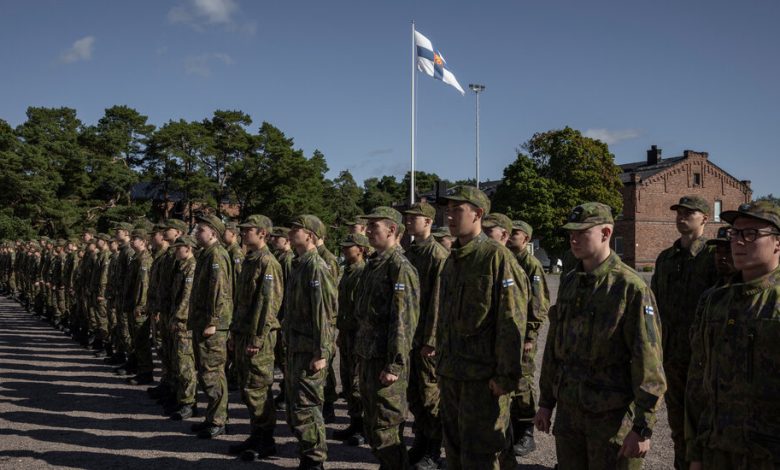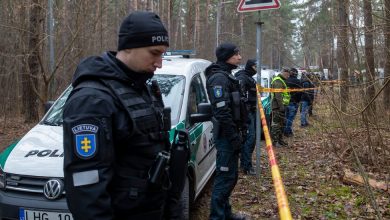When Russia Is a Neighbor, Self-Defense Is Everyone’s Concern

The facade of the apartment building was blown off, the remains sagging to one side. Working together, the military police, the emergency services, the fire department and the explosives team cordoned off the scene, swept for other explosives, disarmed one, and searched for those still alive in the rubble with sniffer dogs, while removing the wounded and the dead.
The scene was staged. The building was an old disused student dormitory. The survivors were volunteers. The dead were dummies, but the body bags, sniffer dogs and soldiers were real, as hundreds of conscripts and reservists practiced how to coordinate civilian and military response to a terrorist attack or a war.
These training exercises go to the core of Finland’s military strategy, to create a force, based on conscription and reservists, capable of fighting should the country go to war — all the more crucial since Russia’s invasion of Ukraine. Each year, some 20,000 or so men are subject to universal male conscription in Finland, while another 1,000 or so women volunteer.
Kasper Wallasvaara, 21, decided to serve after secondary school and working for a while. He eventually wants a job as a teacher or a coach, but he is now learning to shoot a rifle, deal with the aftermath of this urban bomb blast and arrest armed terrorists.
“The reality of war has come much closer,” said Mr. Wallasvaara. “It seems more possible, now that Russia attacked Ukraine. It awakened us.”

Reservists with the Guard Jaeger Regiment, on a firing range at Santahamina base.
Sharing a long combative history with Moscow and a border 830 miles long, Finland never let down its guard, as so many countries did after the Soviet Union collapsed. Even as the newest member of the NATO alliance, it remains committed to the concept of self-defense and self-reliance.
Men in Finland must join the military or do alternative civilian service at some point between 18 and 30 years of age; it is voluntary for women. In peacetime, just 13,000 people serve in the military, 4,500 of them civilians. If needed, Finland has a potential strength of 280,000, consisting of the younger and best trained reservists, with another 590,000 reservists under the age of 60 who have had military training.
Since the invasion, Finland has significantly increased its military budget — and with it, the frequency of the training exercises that are fundamental for new soldiers and reservists.
In a recent exercise in Espoo, the conscripts practiced how to cordon off a building, stealthily approach it and apprehend suspects, ideally without killing them. During the training, one suspect managed to escape, a lapse officers will analyze.
Sofia Nurmi, 19, a volunteer who was part of the exercise, had hoped to serve in the country’s vast forests but was assigned to the military police, who largely serve in cities. Her training has helped her, she said, especially in overcoming her “fear of dark places.” She wanted to stay in the military police, but hasn’t made the grade, she said, disappointed. Now she thinks she will apply to be a border guard — a better chance to serve in the forests.
In another training session, two platoons of soldiers fought a battle through a computer simulation, with one team on the attack and another, in a different room, trying to defend. The simulated exercise is normally repeated on real terrain, with real equipment, their guns equipped with lasers and with sensors on their belts, so they know when they are “killed.”
The reality of Russia’s aggression in Ukraine, officers say, has provided stronger motivation to the conscripts and reservists, while enhancing training on the use of drones, computers and defenses against hacking and disinformation.
“War can happen,” said Eetu Niemela, 20, who works in construction and drives a snowplow in winter. After his training, he said he was thinking about applying to police school and working as an international peacekeeper. He said he was glad Finland had joined NATO, adding, “We never can know what’s going to happen.”
Their commanding officer for the bombing exercise, Col. Vesa Laitonen, 53, said that Russia’s invasion of Ukraine had improved the morale and dedication of the conscripts. “Now they know why they’re in military service,” he said. “Now we can answer the question.”

Finland has fought numerous wars with Russia through the centuries, and it has strong memories of the 1939 “Winter War” and World War II. It beat back the Soviets but lost territory and had to keep a form of neutrality.
Ever since, this country of some 5.6 million people has had to depend on itself, and it has continued to do so even after joining the European Union and now NATO.
It has one of the largest artillery forces in Europe, makes its own rifles and ammunition and cooperates on defense with Sweden and other Nordic countries. The conscripts go through traditional basic training — improving physical fitness, learning to use rifles and other equipment, understanding first aid and practicing maneuvers in the field.
Gen. Timo Kivinen, Finland’s chief of defense, remembered his own conscription 45 years ago, when leaders were less solicitous to new recruits.
“Of course the leadership culture has changed over time,” said General Kivinen, 63. “I wouldn’t say training is softer, but how you lead them and communicate with them is different.”
“If we don’t develop our training system all the time as part of societal development, it doesn’t work,” General Kivinen said. “Conscription creates more resilience than only military capability.”
Women were first allowed to volunteer in 1995. Since then, 12,000 have completed training, said Kati Makkonen of the Finnish defense forces. As volunteers, she said, women tend to be more motivated, and those who stay are rising in the ranks, though not yet to general.
Nora Nordstrom, 21, and Lumi Joutsen, 20, joined this year. They live in a coed barracks room on the military island of Santahamina, home of the Guard Jaeger Regiment and the Finnish National Defense University.
They are part of the same unit and train together with no special treatment for the women, they said.
“There’s a bit more running than I expected,” Ms. Nordstrom said, laughing, but she comes from a military family, so she knew what to expect.

Ms. Joutsen said she always knew she would volunteer. While she is treated equally with the men, she said, “I feel some extra pressure on us to do well.”
Both women said they had not had problems with the male recruits. “Sometimes we forget the whole thing and work together as human beings,” Ms. Nordstrom said. “It surprised me a little.”
Ms. Nordstrom dropped out of training in 2022 with an injury but decided to start again. “When the war started it was a very surreal feeling, wearing these clothes,” she said. “This was war, knowing how close it was to us and we’re here doing this stuff.”
The war looms large.
Kimmo Raja, 34, who works in private equity, has been called back for training exercises several times this year. “Obviously Ukraine has something to do with it,” he said.
Capt. Tuomas Holsa, 55, a management consultant, normally trains once or twice a year, he said. This year, he too, has been called back several times to help retrain reservists, not just in firing weapons but also in leadership.
Between 2021 and 2022, there was a 65 percent increase in compulsory exercises for reservists; a 53 percent increase in military exercises that are voluntary for reservists; and a 300 percent increase in defense training for those who want it.
“We can’t change our neighbor, even if some think that now when we are members of NATO, we can somehow forget Russia,” said Pekka Haavisto, a former foreign minister who chose to do nonmilitary service as a young man but now says he would choose differently.
Since the time of the czars, Russian history has gone “in waves, sometimes imperialistic and aggressive, sometimes more cooperative with the West,” Mr. Haavisto said. “My best guess, based on this 100 years’ history, is that the same waves will continue for the next 100 years, and we have to be prepared for bad times, as well as for the little-bit-better times.”
Johanna Lemola contributed reporting.




